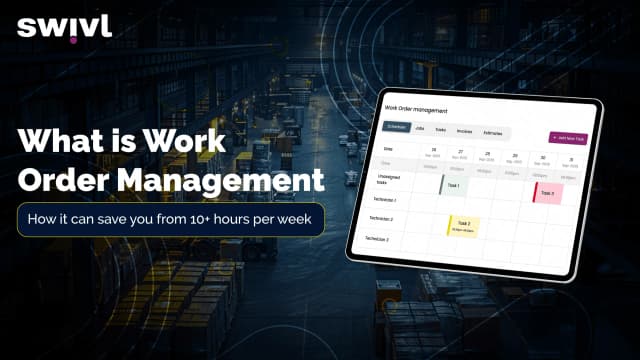Managing maintenance tasks can be daunting; from delays to unexpected costs and frustrated technicians, all these can be exhausting. That’s why you must find ways to stay organized and proactive with your maintenance.
Integrating work order management with asset and inventory tracking can help you avoid the mess since your team will know what needs servicing when it is due, and what items are in stock. Last-minute surprises usually result in unnecessary downtime and unsatisfied clients.
So, if you want to be in better control of your operations, here is an extensive review of how powerful the work order asset inventory integration can be.
Why Does Work Order Asset Inventory Integration Matter
Most companies still use separate systems to manage their operations, assets, and inventory data, but the lack of integration can result in inefficiencies, delays, and poor decision-making. While these systems can work independently, they work even better together. Here’s why it is a good idea to integrate all of these systems.
Eliminates delays and reduces downtime: Linking your asset and inventory data eliminates last-minute surprises and inconveniences. Your technicians will know ahead of their appointments which items are damaged, what parts are required for the job, and whether they are in stock.
Optimizes inventory management: Most companies face challenges such as over-ordering or understocking. Therefore, integrating these systems will help you maintain the right balance. Real-time stocktaking will also help you avoid piling unnecessary stock or delays caused by a shortage of items.
Better budgeting: failing to track your work orders alongside inventories and assets often results in poor budgeting due to the hidden costs you incur from delays or unexpected orders.
Enhances compliance and reporting: Most industries require compliance orders for regulatory purposes. Therefore, integrating these systems will help you automatically store all documents in one place, from work orders to asset maintenance history, making audits easier. Updated reports will make meeting the required safety and operational standards much easier.
How to Integrate Work Order Management with Asset and Inventory Tracking
Want to learn more about field service management?
Download our free guide with actionable tips you can implement today.
Integrating these three systems will help you streamline your workflow, improve equipment reliability, and ensure your technicians have what they need at the right time. Let’s review some of the best ways you can integrate these three systems in your company to help you move from a disconnected to a streamlined system.
1. Select the Right Software
Suppose your current system involves switching from one system to another. In that case, it is time to upgrade to an integrated system that tracks work orders, assets, and inventory data in real time. Selecting an integration software is about convenience, efficiency, and accuracy.
Using the wrong system can slow your operations, create delays, and even unnecessary expenses. The right software, however, can elevate your maintenance and inventory processes, ensuring that all systems running your operations are seamlessly linked. Some of the reasons why you should choose the right software include:
Automation: With the right software, you will have a streamlined workflow where your systems communicate seamlessly. Once a work order is created, it will be automatically assigned to a technician. You can check from the system whether the necessary tools are in stock, instantly remove unavailable tools, and create maintenance logs for future use.
Real-time visibility and control: Knowing where every piece of equipment is, when it was last serviced, and generally everything in stock will help you better control your operations by avoiding downtime, overstocking, and understocking.
Budget optimization: An integrated system will help you cut costs by easily monitoring maintenance costs, avoiding unnecessary repairs, and maximizing the usage of available parts. Real-time tracking of your assets will help you avoid spending on last-minute parts purchases, schedule preventive maintenance on time, and make informed decisions about replacing or repairing your equipment.
Improved compliance and reporting: Having accessible, updated compliance reports can protect your business from fines and legal suits.
Easy access to information for technicians: technicians work well with mobile access since they might not have time to skim through paperwork or call the office.
2. Connect Work Orders to Assets
After creating your work orders, it is best to link them to a specific asset to get a complete maintenance history. Linking your work orders to specific assets will help you identify the repairs done, when they were completed, and who fixed them. Once you have a good understanding of your maintenance history, it will be easy to predict maintenance, which means you will be fixing problems before they escalate.
If you do not track your work orders by specific assets, you might fail to understand whether the equipment is an investment or a liability. However, asset tracking work orders will make it much easier to calculate the exact cost of maintaining each asset, identify which equipment is cost-intensive, and make informed decisions on repairs vs. replacements. Most importantly, connecting work orders and assets enhances faster troubleshooting for technicians since they will have all the information they need in one place.
3. Integrate Work Orders with Inventory
A well-integrated system will automatically deduct parts and any other supplies from the inventory immediately after they are used to complete a work order. With such regular updates, you will not be caught off guard that a missing part is needed. Research indicates that addressing overstocking and understocking can lower inventory costs by up to 10% .
Syncing these two systems ensures that your technicians can access the inventory before they start the job to ascertain whether all the parts required to complete the work order are in stock. Further, technicians can work on urgent work orders without the inconvenience of missing equipment. Therefore, work order inventory management means faster repairs and minimal disruptions, and you will also improve inventory control .
3. Automate Reports and Notifications
Tracking your maintenance, inventory, and assets manually can be draining and time-consuming. Critical issues can slip through the cracks when your team constantly deals with paperwork and looking for information, resulting in inefficiencies, delays, and lost revenue. Therefore, it’s best to set up an integration system that automatically monitors and analyzes assets, work orders, and inventories and alerts the right people.
These real-time notifications and reports will help you avoid downtime since your technicians will be notified immediately when a repair is required, and managers will be alerted when stock levels are down. Timely notifications and automated reports will help you make informed decisions in real time instead of waiting for a manual compilation of reports.
4. Automate Work Order Assignment
Automation plays a key role in the integration of these three systems since it will help you eliminate inefficiencies and human errors which might affect the smooth running of your operations. Automating work order creation and assignment boosts your assets uptime and streamlines inventory management. Manual assignment of work orders usually results in delays and administrative burden. Therefore you need to automate this process to ensure your operations are data driven, and efficient.
Additionally automating work order assignment will help you reduce down time and optimize inventory tracking, enhancing your employees’ productivity. Most importantly an automated work order system easily integrates with asset and inventory tracking to provide real time visibility of your operations. You can easily track your technicians’ performance, spare parts usage, and task completion rates
Final Take
A seamless connection between these three ensures that work orders are automatically connected to available assets, inventory data is updated in real time, and all the documents are available in one place in case your employees want to retrieve them.
A well-integrated system will also help you avoid miscommunication, unexpected downtime, and inefficiencies directly affecting your service delivery. Therefore, if you use separate work orders, inventory, and asset systems, you should join them to streamline asset management and advance your field services.

